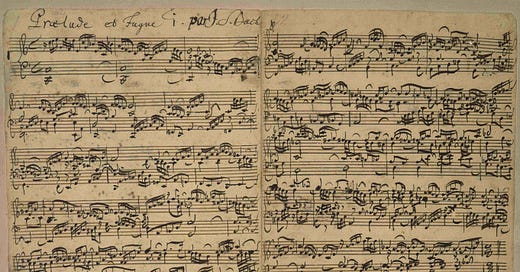This episode features Glenn Gould's 1963 recording of Johann Sebastien Bach's Prelude No. 1 in C Major from The Well-Tempered Clavier Book I, BWV 846 (1722). I also tempo-mapped Gould's performances of other WTC preludes and used them for the tempos of the MIDI versions of the various movements.
A small correction: I say in the episode that five-limit just intonation is the basis for Western European tuning systems. This is only true from the Renaissance onwards. Medieval Europe used Pythagorean (three-limit) tuning. Also, just intonation was probably more of a theoretical ideal than a practical tuning method.
Also, at one point I refer to Bach’s F-sharp major prelude as the F-sharp minor prelude.
I did the alternative tunings using MTS-ESP. I used the following tuning ratios for the just intonation parts:
C - 1/1
C# - 16/15
D - 9/8
Eb - 6/5
E - 5/4
F - 4/3
F# - 45/32
G - 3/2
Ab - 8/5
A - 5/3
Bb - 9/5
B - 15/8
I also used quarter-comma meantone, Andreas Werckmeister's temperament III from 1681, and Johann Kirnberger's well temperament as described in a letter to Johann Nikolaus Forkel in 1779.
In actual practice, Europeans tended to center their tuning around D rather than C. I stick to C for ease of explanation, not historical accuracy.
Here are some real humans performing music in historical European tuning systems:
John Moraitis demonstrates quarter-comma meantone, Rameau and Kirnberger
Alice M. Chuaqui Baldwin demonstrates quarter-comma meantone and Werckmeister III
I decided not to talk about Bradley Lehman’s proposed Bach tuning; I like how it sounds, but the controversy around it was too complicated for me to get into. You can hear Dr Charles Tebbs demonstrating Lehman’s tuning, and if you have a longer attention span than I do, you can watch Lehman tune a harpsichord.
Wikipedia has a good summary of the various theories about Bach's tuning.
John Carlos Baez explains quarter-comma meantone with math and diagrams.
Kyle Gann's web site has lots more material on historical tuning with audio examples.
For a deeper dive, try the tuning and temperament chapters in The Cambridge History of Western Music Theory.













Share this post